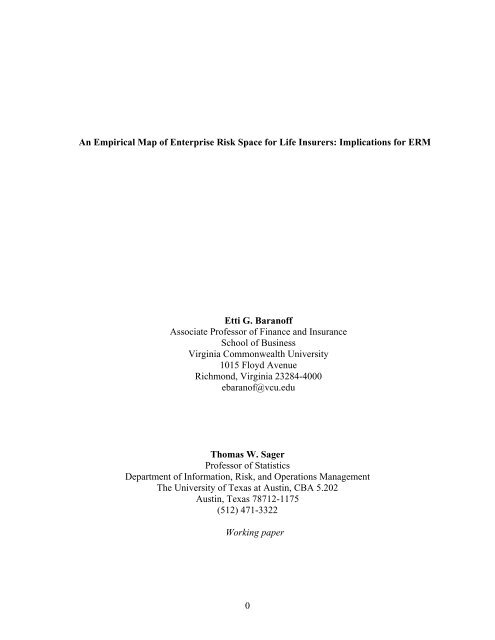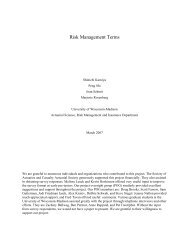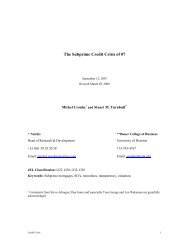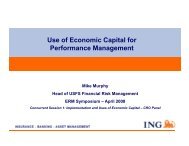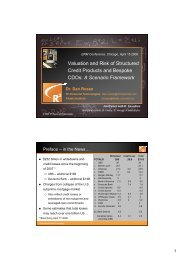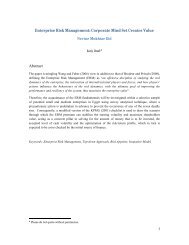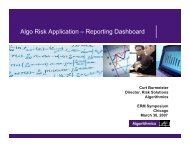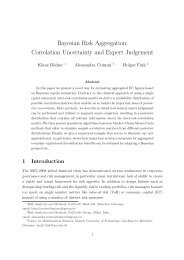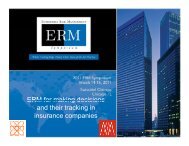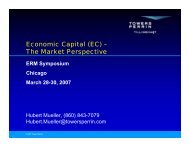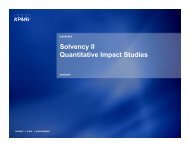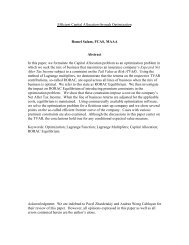An Empirical Map of Enterprise Risk Space for ... - ERM Symposium
An Empirical Map of Enterprise Risk Space for ... - ERM Symposium
An Empirical Map of Enterprise Risk Space for ... - ERM Symposium
You also want an ePaper? Increase the reach of your titles
YUMPU automatically turns print PDFs into web optimized ePapers that Google loves.
<strong>An</strong> <strong>Empirical</strong> <strong>Map</strong> <strong>of</strong> <strong>Enterprise</strong> <strong>Risk</strong> <strong>Space</strong> <strong>for</strong> Life Insurers: Implications <strong>for</strong> <strong>ERM</strong><br />
Etti G. Baran<strong>of</strong>f<br />
Associate Pr<strong>of</strong>essor <strong>of</strong> Finance and Insurance<br />
School <strong>of</strong> Business<br />
Virginia Commonwealth University<br />
1015 Floyd Avenue<br />
Richmond, Virginia 23284-4000<br />
ebaran<strong>of</strong>@vcu.edu<br />
Thomas W. Sager<br />
Pr<strong>of</strong>essor <strong>of</strong> Statistics<br />
Department <strong>of</strong> In<strong>for</strong>mation, <strong>Risk</strong>, and Operations Management<br />
The University <strong>of</strong> Texas at Austin, CBA 5.202<br />
Austin, Texas 78712-1175<br />
(512) 471-3322<br />
Working paper<br />
0
<strong>An</strong> <strong>Empirical</strong> <strong>Map</strong> <strong>of</strong> <strong>Enterprise</strong> <strong>Risk</strong> <strong>Space</strong> <strong>for</strong> Life Insurers: Implications <strong>for</strong> <strong>ERM</strong><br />
Abstract<br />
In this paper we use accounting data <strong>of</strong> the life insurance industry in 2003 to examine the<br />
empirical relationship between the spectrum <strong>of</strong> enterprise risks and the spectrum <strong>of</strong> enterprise<br />
risk management (<strong>ERM</strong>) tools <strong>of</strong> this industry. We find asset and product risk management<br />
tools appropriately interrelated with asset and product risks, but little matching<br />
interrelationship between operational risks and tools despite significant deployment <strong>of</strong><br />
variables to proxy such risks and tools. Following earlier work (Baran<strong>of</strong>f and Sager, 2006),<br />
we design maps <strong>of</strong> risk and <strong>ERM</strong> tool space by extracting over 150 risk variables and over 70<br />
<strong>ERM</strong> variables from insurer annual statements. We group the risk variables into clusters <strong>of</strong><br />
thematically related risks through cluster analysis to determine the groups and through factor<br />
analysis to identify the themes. We similarly group the <strong>ERM</strong> tools. We interpret the risk<br />
clusters as a map <strong>of</strong> risk space and the <strong>ERM</strong> tool clusters as a map <strong>of</strong> tool space. We then<br />
ascertain the relationship between risks and risk-mitigating tools by canonical correlation <strong>of</strong><br />
the most important factors <strong>of</strong> each space. Theoretical conventional wisdom expects that risk<br />
space should be organized into asset, product, and operational risk categories with significant<br />
cross-category overlap generated by financial risk and the risk <strong>of</strong> asset/liability matching<br />
(ALM). The organization <strong>of</strong> tool space is expected to mirror the hypothetical organization <strong>of</strong><br />
risk space, since insurers deploy the tools to mitigate the risks. Our results show that in the<br />
<strong>ERM</strong> tools, the health and life ALM tools are present and mitigate both asset and product<br />
risks. Noticeable by its absence is a role <strong>for</strong> operational risks (except in one factor) or tools.<br />
We provide visual mapping <strong>of</strong> <strong>Risk</strong>s-<strong>ERM</strong> interrelationships <strong>of</strong> insurers. Insurers can place<br />
themselves in any <strong>of</strong> these relational maps or aspire to use them as benchmark tools.<br />
1
<strong>An</strong> <strong>Empirical</strong> <strong>Map</strong> <strong>of</strong> <strong>Enterprise</strong> <strong>Risk</strong> <strong>Space</strong> <strong>for</strong> Life Insurers: Implications <strong>for</strong> <strong>ERM</strong><br />
Introduction<br />
Corporations face a broad spectrum <strong>of</strong> risks, which they try to manage holistically. <strong>Enterprise</strong><br />
risk management (<strong>ERM</strong>) does not supplant, but rather supplements the traditional management<br />
<strong>of</strong> separate risk exposures (Baran<strong>of</strong>f, 2004 A, B and C). As noted in Baran<strong>of</strong>f and Sager (2006),<br />
all aspects <strong>of</strong> risk – pure and speculative – are recognized within the objective to maximize the<br />
firm’s value and as such are <strong>of</strong> interest in <strong>ERM</strong> study. The current article is an extension <strong>of</strong><br />
Baran<strong>of</strong>f and Sager (2006) study <strong>of</strong> life insurers’ risk and <strong>ERM</strong> tool spaces. Whereas the earlier<br />
work focused on discerning the structure <strong>of</strong> risk and tool space, the focus in this article is on the<br />
interactions between the risks and <strong>ERM</strong> tools. To achieve this objective, some <strong>of</strong> the steps <strong>of</strong><br />
Baran<strong>of</strong>f and Sager (2006) are repeated, but with an enhanced set <strong>of</strong> proxies <strong>for</strong> risks and <strong>ERM</strong><br />
tools.<br />
Conventional thinking, depicted in Figure 1, reflects the view that the spectrum <strong>of</strong> enterprise risk<br />
management tools is directed against the spectrum <strong>of</strong> enterprise risks confronting insurers. The<br />
conventional wisdom also expects that risk space should be organized into asset, product, and<br />
operational risk categories with significant cross-category overlap generated by financial risk and<br />
the risk <strong>of</strong> asset/liability matching (ALM). The organization <strong>of</strong> tool space is expected to mirror<br />
the hypothetical organization <strong>of</strong> risk space. We are initially neutral regarding this hypothesis.<br />
Our objective is to determine the empirical reality based on insurer behavior as reflected in their<br />
financial statements.<br />
We use accounting data <strong>of</strong> U.S. life insurers to map the spectrum <strong>of</strong> <strong>ERM</strong> tools and the spectrum<br />
<strong>of</strong> enterprise risks and their interrelationship. These are empirical maps. They show what<br />
insurers actually do with the actual risks they confront, as reflected in their annual statement<br />
data. The maps are also hierarchical. Just as geographic maps show how counties relate to each<br />
other inside states and then inside nations, so the enterprise risk maps figuratively show how<br />
risks relate to each other in themes and the themes to each other in higher-order themes – and<br />
similarly <strong>for</strong> <strong>ERM</strong> tools. Just as geographic maps highlight important cities and roads, so the<br />
enterprise risk maps identify key factors within the themes. The ultimate objective is to<br />
2
understand how the <strong>ERM</strong> tools match up with the risks they were designed to manage. A map<br />
helps us understand the region displayed. By comparing two maps, we can understand how they<br />
interrelate. Our maps are statistical in nature, rather than geographical, based on cluster analytic<br />
groupings, with factor analysis used to reveal their meaning. The process we adopt here,<br />
utilizing Figure 1 <strong>for</strong> illustration, is as follows:<br />
(1) Uncover the best way to analyze the risk space <strong>of</strong> life insurers in order to have a clearer<br />
view <strong>of</strong> the risks. These risks are assumed to be overlapping and dependent to some<br />
extent. (The visual illustration <strong>of</strong> the risks in Figure 1 (Part A) is <strong>for</strong> demonstration only.<br />
Keep in mind the fuzziness <strong>of</strong> relationships.)<br />
(2) Follow the process <strong>of</strong> step (1) <strong>for</strong> the <strong>ERM</strong> tools and activities <strong>of</strong> life insurer (see Figure<br />
1 Part B). For example, one important tool is the asset/liability matching (see Santomero<br />
and Babbel, 1997), and<br />
(3) <strong>An</strong>alyze the relationships between the risks space and the <strong>ERM</strong> tool space (Interrelationship<br />
between Parts A and B in Figure 1). Unlike studies such as Santomero and Babbel (1997) that<br />
used surveys and interviews, our empirical analyses attempt to unveil the actual <strong>ERM</strong> activities<br />
<strong>of</strong> life insurers in response to the risks and visa versa using life isnruers’ own accounting reports.<br />
Our statistical techniques <strong>of</strong>fer the opportunity to convert these data elements into actual stories<br />
about risk exposures and <strong>ERM</strong> behavior.<br />
Using cluster analysis in combination with factor analysis and over 150 variables from the 2003<br />
life insurance annual statement <strong>of</strong> about 1,000 U.S life insurers, this paper attempt to respond to<br />
the main question:<br />
What is the correlation between risk and <strong>ERM</strong> tools?<br />
This can be answered only after we unveil<br />
• The risks <strong>of</strong> life insurance companies<br />
• The <strong>ERM</strong> tools used by insurers, and<br />
Their themes<br />
3
Explanation and Illustration<br />
To illustrate better the objective <strong>of</strong> our study we created Figure 1 noted above, reproduced from<br />
Baran<strong>of</strong>f and Sager (2006). Figure 1 depicts our interpretation <strong>of</strong> the conventional wisdom about<br />
the structure <strong>of</strong> the risks and <strong>ERM</strong> tools <strong>of</strong> financial institutions, and particularly, life insurers. :<br />
(Part A) the space <strong>of</strong> risks, (Part B) the space <strong>of</strong> <strong>ERM</strong>, and (Part C) the interaction between the<br />
risks space in Part A and the <strong>ERM</strong> tools space in Part B.<br />
Part A depicts the risk space <strong>of</strong> life insurers in its <strong>for</strong>m as most commonly apprehended in<br />
current research (i.e. Baran<strong>of</strong>f and Sager, 2002 and 2003, Cummins and Sommer, 1996 and<br />
Shrieves and Dahl, 1992) and in practice. The enterprise risks <strong>of</strong> a life insurer originate from<br />
three broad activities in which life insurers engage: underwriting (product) risks that arise from<br />
selling insurance contracts and policies; asset risks that arise from investing premiums and other<br />
income; and operational risks from engaging in necessary and appropriate supporting activities<br />
as a business entity. Asset/liability matching is considered a major risk overlapping all three<br />
categories and is denoted as a major <strong>ERM</strong> tool.<br />
It is important to note, that the conventional wisdom does not regard these risks as mutually<br />
exclusive. Many risks overlap each other and have fuzzy boundaries. The full story <strong>of</strong> risks is too<br />
complex to portray in detail, given the limitations <strong>of</strong> schematics such as Figure 1.<br />
Part B is the space <strong>of</strong> the <strong>ERM</strong> tools in mitigating the risks described in Part A. This part utilizes<br />
tools discussed by the survey study <strong>of</strong> Santomero and Babbel (1997), RM tools discussed in<br />
Baran<strong>of</strong>f (2004) and many practical tools that can be proxied using accounting data. Again, as in<br />
Part A, <strong>ERM</strong> tools are categorized in three groups: <strong>for</strong> asset risk, <strong>for</strong> product risk and <strong>for</strong><br />
operational risks that flow from Part A. The same complexity that is emphasized <strong>for</strong> Part A is<br />
applicable to Part B.<br />
4
Part C:<br />
Interaction<br />
between <strong>Risk</strong><br />
and <strong>ERM</strong><br />
Tools <strong>Space</strong>s<br />
Part B:<br />
Life Insurers’<br />
<strong>Enterprise</strong> risk<br />
Management<br />
Tools<br />
Part A:<br />
Life Insurers’<br />
<strong>Enterprise</strong><br />
<strong>Risk</strong>s<br />
Figure 1. The Conventional View <strong>of</strong> <strong>Risk</strong> and <strong>ERM</strong> Tools<br />
RISKS <strong>ERM</strong> TOOLS<br />
Capital structure risk Capital structure risk management<br />
Asset/Liability matching risk Asset/Liability matching risk<br />
Asset risk <br />
Product risk <br />
Operational risk <br />
ASSET RISK<br />
Management Tools<br />
• Hedging/derivatives<br />
• Asset allocation<br />
management (Active<br />
vs. passive)<br />
5<br />
management<br />
Asset risk management<br />
Product risk management<br />
Operational risk management<br />
Capital Structure (Financial risk)<br />
Management Tools<br />
Asset/Liability Matching<br />
Management Tools<br />
PRODUCT RISK<br />
Management<br />
Tools<br />
• Reinsurance<br />
• Reserving<br />
• Securitization<br />
• Diversification<br />
SPECTRUM OF RISKS OF LIFE INSURERS<br />
ASSET<br />
RISK<br />
Bonds/Stocks/Cash/<br />
Real<br />
Estate/Mortgages<br />
OPERATIONAL RISK<br />
Management Tools<br />
• Control over agents and<br />
brokers<br />
• Organizational/corporate<br />
structure<br />
• Adherence to regulation<br />
• IT controls<br />
• Operational safety and loss<br />
controls<br />
PRODUCT<br />
RISK<br />
Life/annuities/<br />
Health/reinsurance<br />
OPERATIONAL<br />
RISK<br />
IT systems/legal/<br />
corporate<br />
structure/regulation<br />
Capital Structure (Financial risk)<br />
Asset/Liability Matching<br />
ASSET RISK PRODUCT RISK OPERATIONAL RISK<br />
• Default risk • Catastrophes risk • IT risk
• Volatility risk<br />
(market risk)<br />
• Liquidity risk<br />
Part C illustrates the interaction between parts A and B.<br />
Data, Methodologies and Results<br />
• Incomplete contracts<br />
risk<br />
• Reserves risks<br />
6<br />
• Distribution risk<br />
• Regulatory risk<br />
• Legal risk<br />
• Globalization risk<br />
Since we are working with more than 150 variables, our discussion <strong>of</strong> the data is necessarily<br />
truncated. See the Appendix <strong>for</strong> summary statistics. We undertake the work in 4 steps as<br />
follows:<br />
Following Baran<strong>of</strong>f and Sager (2006), we first map the enterprise risk space <strong>of</strong> life insurers.<br />
Using accounting data <strong>of</strong> life insurers <strong>for</strong> 2003 the risk space is developed using a two-step<br />
methodology: (1) cluster analysis to group risk variables into related clusters, and (2) factor<br />
analysis to uncover the hidden dimensions <strong>of</strong> those clusters. We identified over 150 proxies <strong>for</strong><br />
risk variables in annual report data filed with the NAIC. The results shown here use year 2003<br />
reports <strong>for</strong> nearly 1000 life insurers, and then delete firms lacking in<strong>for</strong>mation or having<br />
anomalous data values, such as negative assets.<br />
Cluster <strong>An</strong>alysis Methodology<br />
The clustering algorithm that we used is hierarchical agglomerative in nature. Note that we<br />
cluster variables rather than insurers. Clustering begins with each risk variable in its own<br />
singleton cluster. It then joins the two risk variables that are most highly correlated. The<br />
algorithm proceeds in this manner, at each step merging the two clusters that are most highly<br />
correlated with each other. Thus, the number <strong>of</strong> remaining clusters is reduced by one at each<br />
step. Eventually the process ends with one super-cluster containing all the variables. By<br />
studying the history <strong>of</strong> the cluster mergers, one can identify a step in which all remaining clusters<br />
are relatively disparate. That step identifies an optimal set <strong>of</strong> clusters <strong>of</strong> risk variables. There is a<br />
degree <strong>of</strong> subjectivity in the selection <strong>of</strong> an “optimal” stopping point in the mergers, since cluster<br />
analysis is more an exploratory technique than a tool with a well-developed theory <strong>of</strong> optimality.<br />
Nonetheless, it can be quite helpful and illuminating. In addition, the analyst has the option <strong>of</strong>
selecting an early stop in order to preserve more structure – or a late stop in order to reveal<br />
higher-order “super-clusters” <strong>of</strong> related clusters. <strong>An</strong> example <strong>of</strong> super-clustering would be the<br />
proposed classification <strong>of</strong> insurer risks into asset, product-liability, and operational categories on<br />
theoretical grounds. Each <strong>of</strong> these large groups could have numerous sub-clusters within it.<br />
Results <strong>of</strong> Cluster <strong>An</strong>alysis <strong>for</strong> <strong>Risk</strong>s<br />
Figure 2 reproduces a dendrogram from the cluster analysis. The dendrogram shows the<br />
historical record <strong>of</strong> cluster mergers from the initial classification <strong>of</strong> each risk variables into its<br />
own separate cluster (at the left <strong>of</strong> the dendrogram) to the final super-cluster <strong>of</strong> all risk variables<br />
(at the right <strong>of</strong> the dendrogram). From study <strong>of</strong> the dendrogram, we selected an eight-cluster<br />
solution.<br />
Figure 2 and Table 1 show the cluster assignments <strong>of</strong> each <strong>of</strong> the risk variables. The cluster<br />
number is an arbitrary label that serves only to identify cluster members and lacks significance in<br />
itself. The clusters may contain many different types <strong>of</strong> categories.<br />
Figure 2 – Eight Main Clusters <strong>for</strong> the <strong>Risk</strong><br />
<strong>Space</strong><br />
7
Table 1 – Clusters <strong>of</strong> the <strong>Risk</strong> Variables (summary statistics <strong>of</strong> all variables are available in<br />
the appendix)<br />
10
RISK VAR CLUSTER RISK VAR CLUSTER<br />
<strong>An</strong>nORDlogNChange 1 LCAP 2<br />
LAInvestedAssets 1 LpAComputersS<strong>of</strong>tware 2<br />
LAtotal 1 LpANetDeferredTaxAsset 2<br />
LBestLikert 1 LpAOtherReceivReins 2<br />
LpAPolicyLoans 1 LpAReceivParentSubsid 2<br />
LpARealEstateOccupiedEncumber 1 LpARecoverableReins 2<br />
LpASeparateAccounts 1 LpATaxFederalForeign 2<br />
LpBond1Private 1 LpClaimsDirectEndThisYr 2<br />
LpBond2Private 1 LpClaimsTOTALBenefitsDuringYr 2<br />
LpBond3Private 1 LpClaimsTOTALSettleDuringYr 2<br />
LpBond4Private 1 Lpgov1 2<br />
LpBond5Private 1 Lpgov2 2<br />
LpBond6Private 1 LpLAgentCommissionsDue 2<br />
LpBprivate 1 LpLCapitalSurplus 2<br />
LpCommDirectDepositType 1 LpLCommonStock 2<br />
Lpcorp12 1 LpLContractClaimsHealth 2<br />
Lpcorp3 1 LpLGeneralExpensesDue 2<br />
Lpcorp4 1 LpLHeldForAgents 2<br />
Lpcorp56 1 LpLInterestMaintReserve 2<br />
LpExAgencyExpenseAllow 1 LpLPaidSurplus 2<br />
LpExAgentBenefitPlans 1 LpLPayableParentSubsidAffil 2<br />
LpExAgentNonfundedBenefitPlans 1 LpLReserveHealth 2<br />
LpExOtherInvestExpense 1 LpLSurplus 2<br />
LpExRealEstateExpense 1 LpLTaxFederalForeign 2<br />
LpLDepositContracts 1 LpLTaxFederalForeignCurrent 2<br />
LpLifeTOTALAmtSurrender 1 LpLTaxFeesNotFederal 2<br />
LpLSeparateAccounts 1 LpLTransferSeparateAccounts 2<br />
LpLSurplusNotes 1 LpRcapital 2<br />
LpSAmortInterestMaintReserve 1 LpSCommissOnPremDepositType 2<br />
LpS<strong>An</strong>nuityBenefits 1 LpSDisabilityAccHealthBenefits 2<br />
LpSChangeSurplusPaidIn 1 pCommDirectRenewal 2<br />
LpSChangeSurplusTransToCapital 1 Phealth 2<br />
LpSDeathBenefits 1 LpADeferPremAgentBal 3<br />
LpSIncomeInvestManageSepAccts 1 LpExReimburseByUninsurAccHealth 3<br />
LpSIncreaseReservesLifeAccHealth 1 LpLOtherEmployeeAgentBenefits 3<br />
LpSInterestContractDepositType 1 LpLPreferredStock 3<br />
LpSMaturedEndowments 1 LpLRetainedAsAgent 3<br />
LpSNetChangeCapitalSurplus 1 LpLTreasuryStockPreferred 3<br />
LpSPaymentsSupplContracts 1 LpSChangeCapitalTransFromSurplus 3<br />
LpSReserveAdjustReinsCeded 1 Plife 3<br />
LpSSurrenderBenefits 1 LpACash 4<br />
LpSTotalL10_19 1 LpClaimsReinsAssEndThisYr 4<br />
Lputil 1 LpCommExpReinsurAssumed 4<br />
LWtotal 1 LpCommExpReinsurCeded 4<br />
Pannuity 1 Lpgov3 4<br />
pCommDirectFirstYrNotSingle 1 Lpgov5 4<br />
pCommDirectFirstYrSingle 1 LpLContractClaimsLife 4<br />
pLReserveLife 1 LpLFundsHeldUnauthReinsur 4<br />
XpClaimsTOTALRecovReinsDuringYr 1 LpLOtherPayableReinsurance 4<br />
LpLReinsurAssumedCommExpAllow 4<br />
11
12<br />
LpSCommissExpOnReinsurAssumed 4<br />
LpSCommissionsExpReinsCeded 4<br />
Preinsur 4<br />
RISK VAR CLUSTER RISK VAR CLUSTER<br />
HealthTOTALlogPolNChange 5 LpExAdvertising 7<br />
LifeTOTALlogPolNChange 5 LpExAgencyConferences 7<br />
LpAOtherNonadmitAssets 5 LpExBooksPeriodicals 7<br />
LpAWriteInNotInvAssets 5 LpExBureauAssocFees 7<br />
LpExEmployBenefitPlans 5 LpExCollectionBankFees 7<br />
LpExInvestigateSettleClaims 5 LpExCPAActuaries 7<br />
LpExOtherAgentWelfare 5 LpExDeprecComputersS<strong>of</strong>tware 7<br />
Lpgov4 5 LpExDeprecFurnitureEquip 7<br />
LpLTreasuryStockCommon 5 LpExGrossAgentBalCharge<strong>of</strong>f 7<br />
LpLWriteInExSurplusFunds 5 LpExGroupServiceAdminFees 7<br />
LpSChangeCapitalPaidIn 5 LpExInsuranceNotRealEstate 7<br />
LpSChangeSurplusForReinsur 5 LpExLegal 7<br />
LpSChangeSurplusTransFromCapital 5 LpExMiscGeneralExpenses 7<br />
LpSCouponsGuarPureEndowments 5 LpExOtherEmployWelfare 7<br />
LpSGroupConversions 5 LpExPhonePostage 7<br />
pSChangeSurplusNotes 5 LpExPrintingStationery 7<br />
pSOtherChangeSurplusSepAccts 5 LpExRent 7<br />
XpClaimsTOTALLiabPaidDuringYr 5 LpExRentEquipment 7<br />
LpAAdjustForeignExch 6 LpExSalaries 7<br />
LpAShortTerm 6 LpExTravel 7<br />
LpCommExpReinsurDiffCed_Ass 6 LpTCE 7<br />
LpExEmpNonfundedBenefitPlans 6 pExMiscLosses 7<br />
LpLAdjAssetLiabForeignExchRate 6 LpACommonStock 8<br />
LpLExperienceRatingRefunds 6 LpLAssetValuationReserve 8<br />
LpLifeTOTALNSurrender 6 LpLNetDeferredTax 8<br />
LpLSurrenderCanceledContracts 6 LpOppA<strong>Risk</strong> 8<br />
LpLWriteInSurplusFunds 6 LpRegA<strong>Risk</strong> 8<br />
LpmuniHI 6 pLUnassignedSurplusFunds 8<br />
LpmuniLO 6<br />
LpSSurplusWithdrawSepAccts 6<br />
LRatingDate 6<br />
LRBCratio 6<br />
LRetOnCap 6<br />
Per<strong>for</strong>mance 6<br />
pSChangeAccountingPrinciples 6<br />
pSChangeCapitalTransToSurplus 6<br />
RBCind 6<br />
We propose the eight clusters as a good cut at a map <strong>of</strong> the geography <strong>of</strong> insurer risk space. We<br />
experimented with more and fewer clusters, but we could not obtain a much better<br />
characterization <strong>of</strong> the clusters <strong>of</strong> risks. To understand the meaning <strong>of</strong> the map, we need to
understand why the variables were clustered as they were. We need to understand the themes that<br />
make one cluster <strong>of</strong> risk variables more related to each other than to another cluster.<br />
Results <strong>of</strong> Cluster <strong>An</strong>alysis <strong>for</strong> <strong>ERM</strong> Tools<br />
Following the same process <strong>of</strong> clustering the risk variables, we also create the clusters <strong>for</strong> the<br />
<strong>ERM</strong> tools variables. Figure 3 and Table 2 show the 8 clusters selected <strong>for</strong> the <strong>ERM</strong> space.<br />
Figure 3 – Eight Main Clusters <strong>for</strong> the <strong>ERM</strong> Tools <strong>Space</strong><br />
13
Table 2 - Clusters <strong>of</strong> the <strong>ERM</strong> Tools Variables [summary statistics are available in the<br />
Appendix]<br />
<strong>ERM</strong> TOOL VAR CLUSTER <strong>ERM</strong> TOOL VAR CLUSTER<br />
IndDeriv 1 LpExInspectionReports 4<br />
LBestLikert 1 LpExMedicalExams 4<br />
LDeriv_TotalBookValue 1 LpLife_ALM_1 4<br />
LExTOTALGeneralExpense 1 LpLife_ALM_3 4<br />
LLTotalLiabilities 1 LpSAmortInterestMaintReserve 4<br />
Lp<strong>An</strong>nuities_ALM 1 LpSIncreaseReservesLifeAccHealth 4<br />
LpDeriv_TotalBookValue 1 pLReserveLife 4<br />
LpLDepositContracts 1 LpExInvestigateSettleClaims 5<br />
LpSInterestContractDepositType 1 LpHealth_ALM_1 5<br />
LRTotcap 1 LpHealth_ALM_2 5<br />
LWtotal 1 LpHealth_ALM_3 5<br />
Tstates 1 LpHealth_ALM_4 5<br />
LifeTOTALlogPriceChange 2 LpIntMaintReserve_ALM 5<br />
LpSReserveAdjustReinsCeded 2 LpLInterestMaintReserve 5<br />
LRatingDate 2 LpLReserveHealth 5<br />
LpAOtherReceivReins 3 LpSCommissOnPremDepositType 5<br />
LpARecoverableReins 3 LpSGeneralInsurExpenses 5<br />
LpClaimsLiabReinsCededDec31 3 LpSTaxFederalForeign 5<br />
LpClaimsLiabReinsCededEndLastYr 3 LActiveIndex1 1 6<br />
LpClaimsReinsCededEndThisYr 3 LActiveIndex2 2 6<br />
LpClBenefitsReinsCededIncThisYr 3 LActiveIndex3 3 6<br />
LpClRecovableFromReinsDec31 3 LpAssetValuationReserve_ALM 6<br />
LpClRecovableFromReinsEndLastYr 3 LpLAssetValuationReserve 6<br />
LpClSettleReinsCededIncThisYr 3 HealthTOTALlogPriceChange 7<br />
LpExCPAActuaries 3 LpLBorrowedMoney 7<br />
LpLCapitalSurplus 3 LpLSurplusNotes 7<br />
LpLFundsHeldUnauthReinsur 3 LpLTreasuryStockPreferred 7<br />
LpLife_ALM_2 3 Ngroup 7<br />
LpLife_ALM_4 3 XpClaimsTOTALReinsCededDuringYr 7<br />
LpLPaidSurplus 3 LpExLegal 8<br />
LpLSurplus 3 LpLTreasuryStockCommon 8<br />
1<br />
The ActiveIndex and Per<strong>for</strong>mance <strong>for</strong>mulas. The lag values are available from the previous year's data, which are<br />
in the dataset from which these vars are extracted.<br />
ActiveIndex1 = (ABS(rBUY_Bonds - lagrBUY_Bonds) + ABS(rBUY_Stocks - lagrBUY_Stocks)<br />
+ABS(rBUY_Mortgages - lagrBUY_Mortgages) + ABS(rBUY_RealEstate - lagrBUY_RealEstate)<br />
+ABS(rBUY_OtherInvestedAssets - lagrBUY_OtherInvestedAssets))/5;<br />
2 ActiveIndex2 = (ABS(rBUY_Bonds - pCF_Bonds) + ABS(rBUY_Stocks - pCF_Stocks)<br />
+ABS(rBUY_Mortgages - pCF_Mortgages) + ABS(rBUY_RealEstate - pCF_RealEstate)<br />
+ABS(rBUY_OtherInvestedAssets - pCF_OtherInvestedAssets))/5;<br />
3 ActiveIndex3 = (ABS(rBUY_Bonds - pBonds) + ABS(rBUY_Stocks - pStocks)<br />
+ABS(rBUY_Mortgages - pMortgages) + ABS(rBUY_RealEstate - pRealEstate)<br />
+ABS(rBUY_OtherInvestedAssets - pOtherInvestedAssets))/5;<br />
15
LpLWriteInExSurplusFunds 3 LpLWriteInSurplusFunds 8<br />
LpSCommissExpOnReinsurAssumed 3 pSChangeReserveForValuationBasis 8<br />
LpSCommissionsExpReinsCeded 3<br />
Ntype 3<br />
pLUnassignedSurplusFunds 3<br />
pSChangeAssetValuationReserve 3<br />
pSChangeLiabReinsurUnauthCo 3<br />
XpClBenefitsReinsCededIncThisYr 3<br />
Factor <strong>An</strong>alysis Methodology to Uncover the Themes <strong>of</strong> the <strong>Risk</strong> and <strong>ERM</strong> Tools Clusters<br />
Factor <strong>An</strong>alysis uncovers the hidden themes <strong>of</strong> the clusters. As you will see below, the<br />
factor analysis uncovered the first two or three factors in 5 <strong>of</strong> the 8 risks clusters only and also in<br />
5 <strong>of</strong> the 8 <strong>ERM</strong> tools clusters.<br />
Factor analysis attempts to determine the underlying (latent, unobserved, or common)<br />
factors that account <strong>for</strong> observed variables X1, X2, ..., Xp when it is not possible to directly<br />
measure the true underlying causes <strong>of</strong> X1, X2, ..., Xp . Factor analysis attempts to determine the<br />
number <strong>of</strong> such factors, to estimate them, and to interpret their meaning. The following is a brief<br />
sketch <strong>of</strong> the factor analysis model and assumptions:<br />
(a) There are m common factors ξ1, ..., ξm that underlie p (p > m) variables X1, X2, ..., Xp.<br />
(b) Each variable Xi is a linear combination <strong>of</strong> one or more common factors and a unique factor<br />
εi (unique to Xi):<br />
X1<br />
= λ11ξ1<br />
+ λ12ξ2<br />
+ L+<br />
λ1mξ<br />
m + ε1<br />
X 2 = λ21ξ1<br />
+ λ22ξ2<br />
+ L+<br />
λ2mξ<br />
m + ε 2<br />
M<br />
X = λ ξ + λ ξ + L+<br />
λ ξ + ε<br />
p<br />
p1<br />
1<br />
p2<br />
2<br />
Each ξj contributes to at least two variables (at least two <strong>of</strong> λ1j, λ2j, λ3j, ..., λpj are<br />
nonzero), <strong>for</strong> if only one λij ≠ 0, <strong>for</strong> some i = 1, 2, ..., p, then ξj would really be part <strong>of</strong> the<br />
unique factor <strong>for</strong> that Xi.<br />
(c) All ξ's and X's are standardized to mean 0, stdev 1. 4<br />
(d) corr(εi, εj) = 0 <strong>for</strong> all i,j, i ≠ j 5<br />
4 We will not suppose that the unique term ε is standardized, although we will assume that ε has mean zero. Thus<br />
Var(ε) need not be 1.<br />
16<br />
pm<br />
m<br />
p
(e) corr(ξi, εj) = 0 <strong>for</strong> all i,j 6<br />
(f) [Initially] corr(ξi, ξj) = 0 <strong>for</strong> all i,j, i ≠ j. I.e., the initial extracted factors are uncorrelated<br />
(orthogonal).<br />
Results <strong>of</strong> Factor <strong>An</strong>alysis within the <strong>Risk</strong> Clusters and <strong>ERM</strong> Clusters -- Creation <strong>of</strong> the <strong>Risk</strong><br />
and <strong>ERM</strong> Tools <strong>Map</strong>s<br />
We look to the first few factors to determine the meaning <strong>of</strong> the cluster. The first few factors are<br />
usually responsible <strong>for</strong> a substantial proportion <strong>of</strong> the variability <strong>of</strong> the cluster variables (denoted<br />
by the eigenvalue). <strong>An</strong>d the meaning <strong>of</strong> a factor can be gleaned from the variables with highest<br />
factor loadings. For those clusters with high eigenvalues (high variance explained by each<br />
factor), Table 3 shows the loadings <strong>for</strong> the most significant factors in each <strong>of</strong> the <strong>of</strong> these risk<br />
clusters. We also provide our interpretation <strong>of</strong> the resultant themes <strong>of</strong> the clusters.<br />
Table 3 - <strong>Risk</strong> <strong>Space</strong> - Factor Loadings <strong>for</strong> the Clusters with High Variance Explained by<br />
the Factors (Eigenvalues) and their Themes<br />
Cluster 1<br />
Factor Number Eigenvalue<br />
1 9.696722<br />
2 3.746450<br />
3 2.679885<br />
Theme<br />
Variable Factor1 Low Liquidity – Asset risk<br />
LAtotal 0.876416<br />
LAInvestedAssets 0.841905<br />
LpBond2Private 0.818397<br />
LpBprivate 0.818267<br />
LWtotal 0.753522<br />
LpBond1Private 0.737044<br />
LpBond3Private 0.715046<br />
Variable Factor2 Life product risks<br />
LpAPolicyLoans 0.523196<br />
5 This is a natural assumption: If two ε‘s could be correlated, then part <strong>of</strong> their effects would be in common to their<br />
two X-variables and not unique to their separate X-variables.<br />
6 This is a natural assumption: If a common factor correlates with another unique factor, then that other unique<br />
factor is not unique to its X-variable, but also shares in the explanation <strong>of</strong> the X-variable <strong>of</strong> the common factor. <strong>An</strong>d<br />
if a common factor correlates with its own unique factor, then that unique factor necessarily correlates with another<br />
X-variable (because the common part is, after all, in common to the X-variables), and so is also not unique.<br />
17
pLReserveLife 0.497873<br />
LpSDeathBenefits 0.456245<br />
Variable Factor3<br />
LpSIncreaseReservesLifeAccHealth 0.640158 Reserves risk – Product risk<br />
LpSTotalL10_19 0.595813<br />
pLReserveLife 0.522153<br />
Cluster 2<br />
Factor Number Eigenvalue<br />
1 8.83019<br />
2 3.62399<br />
Variable Factor1 Claims settlements – Product risk<br />
LpClaimsDirectEndThisYr 0.895912<br />
LpClaimsTOTALSettleDuringYr 0.872350<br />
LpClaimsTOTALBenefitsDuringYr 0.825972<br />
LpLContractClaimsHealth 0.799585<br />
Phealth 0.757487<br />
LpLCapitalSurplus 0.739532<br />
Variable Factor2 Product (health)/Operational (Commission)<br />
LpSCommissOnPremDepositType 0.599825<br />
LpSDisabilityAccHealthBenefits 0.552968<br />
Cluster 4<br />
Factor Number Eigenvalue<br />
1 3.259321<br />
2 1.479996<br />
Variable Factor1<br />
Preinsur 0.854684 Reinsurance assumed (commission and claims)<br />
LpCommExpReinsurAssumed 0.813689<br />
LpSCommissExpOnReinsurAssumed 0.802858<br />
LpClaimsReinsAssEndThisYr 0.702083<br />
Variable Factor2 Commission on Reinsurance ceded<br />
LpSCommissionsExpReinsCeded 0.745985<br />
LpCommExpReinsurCeded 0.515113<br />
Cluster 7<br />
Factor Number Eigenvalue<br />
1 6.330915<br />
2 2.166834<br />
Variable Factor1 Operational expenses<br />
LpExPrintingStationery 0.773015<br />
18
LpExOtherEmployWelfare 0.736351<br />
LpExRentEquipment 0.668938<br />
Variable Factor2<br />
LpExCPAActuaries 0.293973 Operational expenses<br />
Cluster 8<br />
Factor Number Eigenvalue<br />
1 3.149836<br />
Variable Factor1 Asset <strong>Risk</strong><br />
LpRegA<strong>Risk</strong> 0.945318<br />
LpACommonStock 0.925597<br />
LpOppA<strong>Risk</strong> 0.856042<br />
Table 3 shows that the themes <strong>of</strong> the risk map correspond to various aspects <strong>of</strong> the risks depicted<br />
in Figure 1 – asset, product, and operational risks.<br />
Table 4 replicates the process <strong>for</strong> the <strong>ERM</strong> tools map. Again, we focus on the clusters where the<br />
factors have high eigenvalues. Table 4 provides the <strong>ERM</strong> tools map that emerged <strong>for</strong> the life<br />
insurers in 2003. We see that asset/liability matching <strong>for</strong> each line <strong>of</strong> life insurance is part <strong>of</strong> the<br />
map as well as capital management and reinsurance. We included special proxies <strong>for</strong><br />
active/passive asset allocation strategies and they also emerge as a theme <strong>of</strong> cluster 6.<br />
Reinsurance as a tool and inspection also emerge as part <strong>of</strong> the <strong>ERM</strong> tools map.<br />
Table 4 – <strong>ERM</strong> Tools <strong>Space</strong> - Factor Loadings <strong>for</strong> the Clusters with High Variance<br />
Explained by the Factors (Eigenvalues) and their Themes<br />
Cluster 1<br />
Factor Number Eigenvalue<br />
1 4.777433<br />
2 1.919287<br />
19<br />
Themes<br />
Variable Factor1 Size and derivatives<br />
LLTotalLiabilities 0.886553<br />
LWtotal 0.782013<br />
LRTotcap 0.708080<br />
IndDeriv 0.706148<br />
Variable Factor2 <strong>An</strong>nuities ALM<br />
LpLDepositContracts 0.760578
Lp<strong>An</strong>nuities_ALM 0.748365<br />
Cluster 3<br />
Factor Number Eigenvalue<br />
6.097146<br />
2.694351<br />
Variable Factor1 Reinsurance ceded<br />
LpClaimsLiabReinsCededDec31 0.900162<br />
LpClaimsReinsCededEndThisYr 0.900162<br />
LpClaimsLiabReinsCededEndLastYr 0.862172<br />
LpClSettleReinsCededIncThisYr 0.840958<br />
XpClBenefitsReinsCededIncThisYr 0.826632<br />
Variable Factor2 Capital management<br />
LpLSurplus 0.853020<br />
LpLCapitalSurplus 0.826342<br />
LpLPaidSurplus 0.822995<br />
Cluster 4<br />
Factor Number Eigenvalue<br />
1 2.591291<br />
2 1.502502<br />
Variable Factor1 Life ALM<br />
LpLife_ALM_1 0.936286<br />
LpLife_ALM_3 0.894617<br />
pLReserveLife 0.878939<br />
Variable Factor2<br />
LpExInspectionReports 0.860757 Inspections and exams (Operational)<br />
LpExMedicalExams 0.829734<br />
Cluster 5<br />
Factor Number Eigenvalue<br />
1 4.156133<br />
2 1.887307<br />
Variable Factor1 Health ALM<br />
LpHealth_ALM_1 0.897746<br />
LpHealth_ALM_3 0.866827<br />
LpHealth_ALM_4 0.844573<br />
LpLReserveHealth 0.844375<br />
LpHealth_ALM_2 0.830254<br />
Variable Factor2 Maintenance reserve<br />
LpLInterestMaintReserve 0.915656<br />
LpIntMaintReserve_ALM 0.883388<br />
20
Cluster 6<br />
Factor Number Eigenvalue<br />
1 2.879384<br />
Variable Factor1<br />
LpAssetValuationReserve_ALM 0.812446<br />
LActiveIndex3 0.794990<br />
LpLAssetValuationReserve 0.764336<br />
LActiveIndex1 0.742731<br />
LActiveIndex2 0.671897<br />
The Relationship Between <strong>Risk</strong> and <strong>ERM</strong> Tools <strong>Map</strong>s<br />
21<br />
Asset allocation strategies and asset valuation<br />
reserves<br />
As noted above, the objective <strong>of</strong> this paper is to examine the interrelationship between the map<br />
<strong>of</strong> risk space and the map <strong>of</strong> <strong>ERM</strong> tool space. In order to do this, we used the factors <strong>of</strong> each <strong>of</strong><br />
the risk and <strong>ERM</strong> tools clusters shown in Tables 3 and 4 and also included the first one or two<br />
factors <strong>of</strong> the mixed clusters that did not emerge as having a clear theme during the factor<br />
analysis step. We use 18 factors selected from risk space and 14 from <strong>ERM</strong> tool space. With<br />
these two sets <strong>of</strong> factors to represent their respective spaces, we then interrelated them using the<br />
canonical correlation methodology.<br />
Canonical correlation is a generalization <strong>of</strong> multiple regression in which multiple response<br />
variables are permitted, in addition to multiple predictors. Moreover, the direction <strong>of</strong> the<br />
relationship need not be specified. In the case at hand, we view that as an advantage. One can<br />
argue plausibly that the <strong>ERM</strong> tools employed by an insurer are a function <strong>of</strong> the risks assumed.<br />
But one could argue just as plausibly, in our view, that the risks assumed are a function <strong>of</strong> and<br />
limited by the tools available to mitigate them. Some would there<strong>for</strong>e argue <strong>for</strong> a simultaneous<br />
equations approach, with both risks and tools expressed as functions <strong>of</strong> each other and <strong>of</strong> other<br />
predictors. However, there are so many risks and tools that the proliferation <strong>of</strong> equations might<br />
overwhelm human ability both to specify and to make sense <strong>of</strong> them. Moreover, the<br />
simultaneous equations approach would define both risks and <strong>ERM</strong> tools implicitly as functions<br />
<strong>of</strong> a common set <strong>of</strong> instruments in reduced <strong>for</strong>m. We are not yet persuaded <strong>of</strong> the truth <strong>of</strong> such an<br />
assumption. Following is a brief description <strong>of</strong> the canonical correlation methodology.
Canonical Correlation <strong>An</strong>alysis Methodology<br />
In canonical correlation, we are interested in the interrelationship between one group <strong>of</strong><br />
variables Y1, Y2, ..., Yq and another group X1, X2, ..., Xp . Note that multiple regression is a special<br />
case <strong>of</strong> canonical correlation in which the Y-group contains only one variable. Formally, in<br />
canonical correlation models, after standardizing both the X’s and the Y’s, the model finds a pair<br />
<strong>of</strong> linear combinations<br />
W1 = α11*X1 + α12*X2 + ... + α1p*Xp<br />
V1 = β11*Y1+ β12*Y2 + ... + β1p*Yq<br />
that have maximum correlation with each other. Thus W1 best represents the X’s in explaining<br />
the Y’s, and V1 best represents the Y’s in explaining the X’s. <strong>An</strong>d together, (W1, V1) best<br />
explain the relationship between the Y’s and the X’s.<br />
Once the first pair (W1, V1) have been chosen, the search begins <strong>for</strong> a second pair:<br />
W2 = α21*X1 + α22*X2 + ... + α2p*Xp<br />
V2 = β21*Y1 + β22*Y2 + ... + β2p*Yq<br />
chosen to have maximum correlation with each other, subject to W2 being uncorrelated with W1<br />
and V1, and V2 being uncorrelated with W1 and V1. The idea is that (W2, V2) should do the best<br />
possible job <strong>of</strong> explaining what remains to be explained <strong>of</strong> the relationship between the Y’s and<br />
the X’s, after the first pair have had their say. The process <strong>of</strong> finding pairs <strong>of</strong> linear<br />
combinations continues until m = min(p,q) pairs have been found. Interpretation <strong>of</strong> the linear<br />
combinations is in<strong>for</strong>med by principles similar to those involved in interpreting factors in factor<br />
analysis.<br />
Canonical Correlation Results<br />
To apply canonical correlation, we selected the q = 14 important factors from <strong>ERM</strong> tool space to<br />
use as 1 , Y2<br />
,..., Y14<br />
Y and the p = 18 important factors from <strong>Risk</strong> space to use as 1 2 18<br />
22<br />
X , X ,..., X .<br />
Table 5 shows the first five canonical variate pairs (<strong>ERM</strong>1-<strong>ERM</strong>5 and RISK1-RISK5). <strong>ERM</strong>1 is
paired with RISK1, <strong>ERM</strong>2 with RISK2, etc. These five canonical pairs explain 41%, 26%, 16%,<br />
5%, and 5% <strong>of</strong> the total interrelationship between the selected risk factors and <strong>ERM</strong> tool factors,<br />
respectively, and have canonical R-squares <strong>of</strong> 0.88, 0.82, 0.75, 0.50, and 0.47. 7 The table<br />
displays the correlations <strong>of</strong> each canonical variate with the <strong>ERM</strong> or RISK factors that it<br />
represents. These loadings are used as in factor analysis to obtain the meanings <strong>of</strong> the canonical<br />
variates. Shading indicates the most important loadings <strong>for</strong> interpretation, in our view.<br />
Table 5A. Correlations Between the <strong>ERM</strong> Tool Factors and Their Canonical Variates<br />
Factor Theme <strong>ERM</strong>1 <strong>ERM</strong>2 <strong>ERM</strong>3 <strong>ERM</strong>4 <strong>ERM</strong>5<br />
<strong>ERM</strong>clus1F1 Sophistication (size and derivatives) 0.6879 -0.1155 0.6450 -0.0631 0.1461<br />
<strong>ERM</strong>clus1F2 <strong>An</strong>nuities ALM -0.0024 -0.2872 -0.2070 0.1231 0.0097<br />
<strong>ERM</strong>clus2F1 Mixture 0.0903 0.0035 0.0421 -0.0472 0.1167<br />
<strong>ERM</strong>clus3F1 Reinsurance ceded -0.4959 0.5127 0.0413 0.3091 0.5803<br />
<strong>ERM</strong>clus3F2 Capital management -0.7470 -0.4706 0.2031 -0.3146 -0.2107<br />
<strong>ERM</strong>clus4F1 Life ALM 0.3505 -0.3994 -0.6143 0.3632 0.0942<br />
<strong>ERM</strong>clus4F2 Monitoring (inspections and medical exams) 0.1448 -0.0282 -0.2146 0.2499 -0.1243<br />
<strong>ERM</strong>clus5F1 Health ALM -0.2410 0.7747 0.2156 -0.0500 -0.3546<br />
<strong>ERM</strong>clus5F2 Maintenance reserve -0.3208 -0.2089 0.2089 -0.0454 0.1230<br />
<strong>ERM</strong>clus6F1 Asset allocation and reserve strategy -0.1884 -0.2794 0.5089 0.7208 -0.2118<br />
<strong>ERM</strong>clus7F1 Mixture 0.2725 -0.0284 0.1377 -0.0894 0.0275<br />
<strong>ERM</strong>clus7F2 Mixture 0.0526 -0.1689 0.1795 -0.2429 0.1332<br />
<strong>ERM</strong>clus8F1 Mixture -0.1447 -0.1391 -0.0050 0.0136 0.0271<br />
<strong>ERM</strong>clus8F2 Mixture -0.0094 0.0632 -0.0370 0.0468 0.0139<br />
Table 5B. Correlations Between the <strong>Risk</strong> Factors and Their Canonical Variates<br />
Factor Theme RISK1 RISK2 RISK3 RISK4 RISK5<br />
RISKclus1F1 Liquidity and credit - asset risk 0.7715 -0.0901 0.5400 -0.2154 0.0888<br />
RISKclus1F2 Life risks: policy loans; reserves; death<br />
benefits - product risk<br />
23<br />
0.1094 -0.0417 -0.2108 0.2750 -0.0240<br />
RISKclus1F3 Reserves risk 0.4563 -0.1071 -0.5074 0.2839 0.1297<br />
RISKclus2F1 Claims settlements -0.8147 0.4712 0.1173 0.0312 -0.0739<br />
RISKclus2F2 Product (health)/Operational (Commission) 0.1381 0.8868 0.0513 0.0597 -0.3050<br />
RISKclus3F1 Mixture 0.0107 -0.2530 -0.4809 0.3381 0.0113<br />
RISKclus3F2 Mixture 0.0565 -0.0786 -0.0063 0.2725 -0.0690<br />
RISKclus4F1 Reinsurance assumed -0.1488 0.2988 0.0840 0.3785 0.5163<br />
7 For example, 0.88 = corr(RISK1,<strong>ERM</strong>1) 2 , etc.
RISKclus4F2 Commission on reinsurance ceded 0.0186 0.3696 -0.0632 0.3069 0.5735<br />
RISKclus5F1 Mixture -0.0837 0.1605 -0.0657 -0.0263 -0.2833<br />
RISKclus5F2 Mixture 0.0338 0.0280 0.0091 -0.0635 0.0302<br />
RISKclus5F3 Mixture 0.0433 -0.1208 -0.2136 0.1132 -0.0235<br />
RISKclus6F1 Mixture -0.1131 -0.1454 0.0957 -0.1971 0.1637<br />
RISKclus6F2 Mixture 0.1571 0.2512 -0.0029 -0.0126 0.0421<br />
RISKclus6F3 Mixture -0.1312 -0.0891 -0.0628 0.1091 0.1525<br />
RISKclus7F1 Operational expenses 0.1690 0.0732 0.0004 0.1270 -0.3551<br />
RISKclus7F2 Actuarial expenses -0.3405 -0.1327 -0.1855 -0.0182 0.2639<br />
RISKclus8F1 Asset risks -0.3419 -0.3705 0.5421 0.5899 -0.2254<br />
Interpretation<br />
The first dimension (<strong>ERM</strong>1-RISK1) explains 41% <strong>of</strong> the interrelationship, and the associated<br />
canonical pairs are closely related (R-square = 0.88) as the plot in Figure 2 demonstrates.<br />
Insurers with high scores on RISK1 tend to be large with large holdings <strong>of</strong> illiquid privately<br />
placed assets and low levels <strong>of</strong> claims. Insurers with low scores on RISK1 tend to be small, with<br />
high liquidity and high bonds credit but also high claims exposures through risky products. On<br />
the <strong>ERM</strong>1 side, high scorers tend to be sophisticated (use derivatives), larger in size and employ<br />
lower financial leverage in capital management, and cede less reinsurance to manage risk. Low<br />
scorers on <strong>ERM</strong>1 have opposite characteristics. The pairing <strong>of</strong> these risk and tool characteristics<br />
on the <strong>ERM</strong>1-RISK1 dimension suggests a dimension characterized by reliance upon<br />
sophistication both in capital and derivatives management with exploitation <strong>of</strong> size on the <strong>ERM</strong><br />
side while taking more asset risk and less product risk on the risk map side.<br />
The second dimension <strong>of</strong> the <strong>Risk</strong>-<strong>ERM</strong> interrelationship (<strong>ERM</strong>2-RISK2) emphasizes health<br />
Asset/Liability Matching, reinsurance, and capital management (more leverage) tools paired with<br />
a mix <strong>of</strong> product risk and operational risk in commissions. Insurers that score high on RISK2<br />
have high disability benefits and commissions on deposit funds (which is the only place where<br />
operational risk appears in this interrelationship).. Insurers that score high on <strong>ERM</strong>2 deploy<br />
health ALM and reinsurance tools, but use more leverage. The second dimension <strong>of</strong> the <strong>Risk</strong>-<br />
<strong>ERM</strong> interrelationship appears to be a product dimension on the risk side, with small operational<br />
contributions, while on the <strong>ERM</strong> side it overlaps all functions in both health ALM and capital<br />
management.<br />
24
The third dimension (<strong>ERM</strong>3-RISK3) emphasizes asset risks on the <strong>Risk</strong> side and asset risk<br />
management tools on the <strong>ERM</strong> side. We find a recurrence <strong>of</strong> firms with illiquid private<br />
placements and asset risk overall on the high side <strong>of</strong> RISK3, together with size and sophistication<br />
on the high side <strong>of</strong> <strong>ERM</strong>3. But on the high end <strong>of</strong> RISK3, we also find firms with high overall<br />
asset risk and some product risk, together with low reserves. <strong>An</strong>d on the high side <strong>of</strong> <strong>ERM</strong>3, we<br />
add firms with significant asset allocation and reserve measures (product risk) coupled with low<br />
ALM <strong>for</strong> life products.<br />
The fourth and fifth dimensions each explain about 5% <strong>of</strong> the RISK-<strong>ERM</strong> interrelationship.<br />
Their interpretations are fairly straight<strong>for</strong>ward. The fourth dimension pairs asset risks with asset<br />
allocation and reserve strategies. The fifth relates reinsurance risks (assumed) with reinsurance<br />
tools (ceded).<br />
We emphasize that each canonical pair (dimension) <strong>of</strong> the interrelationship is orthogonal to<br />
every other pair and there<strong>for</strong>e provides a separate and distinct perspective on a different aspect <strong>of</strong><br />
the interrelationship. Together, these five dimensions explain about 93 percent <strong>of</strong> the<br />
interrelationship. To be sure, each side <strong>of</strong> the RISK-<strong>ERM</strong> interrelationship has been simplified<br />
through the selection <strong>of</strong> the most important factors on each side (14 <strong>for</strong> <strong>ERM</strong> and 18 <strong>for</strong> RISK).<br />
Conceivably, a different picture could emerge through the inclusion <strong>of</strong> more, or different,<br />
factors. However, the themes that emerge from the analysis are satisfyingly consistent. The<br />
theme <strong>of</strong> the most important dimension, <strong>ERM</strong>1-RISK1, is characterized by size, leverage and<br />
sophistication on the <strong>ERM</strong> side against high asset risk and low product risk. Insurers are placed<br />
along its risk dimension by their assumption (or not) <strong>of</strong> assets risks, and along its <strong>ERM</strong><br />
dimension by their employment <strong>of</strong> sophisticated tools, including derivatives. Insurers are also<br />
placed on a second dimension that represents a mix <strong>of</strong> product and asset risks and corresponding<br />
tools. The third and fourth dimensions correspond to different aspects <strong>of</strong> asset risks and tools.<br />
<strong>An</strong>d the fifth is a specific type <strong>of</strong> product risk and tool – reinsurance. Noteworthy is the presence<br />
on the <strong>ERM</strong> side <strong>of</strong> ALM tools <strong>for</strong> two <strong>of</strong> the 3 main products sold by this industry – life and<br />
health (ALM <strong>for</strong> annuities did not emerge in the relationship). Noticeable by its absence is any<br />
presence <strong>for</strong> operational risks (except in one factor) or tools. Although many operational risk<br />
25
variables and tools were included in the study, and operational risks/tools do play roles in certain<br />
clusters and factors, none emerges to assume control <strong>of</strong> a significant aspect <strong>of</strong> the <strong>ERM</strong>-RISK<br />
interrelationship, except in minor roles. Figure 4 below provides the visual mapping <strong>of</strong> insurers<br />
in each <strong>of</strong> the interrelationships described here. As the reader can see, the maps and the<br />
relationships are spectra. Each insurer is positioned at a point in every <strong>Risk</strong>-<strong>ERM</strong> dimension.<br />
Thus, an insurer may use the plots in Figure 4 as a benchmark tool.<br />
Figure 4- Interrelationships Between the <strong>Risk</strong> Spectrums and <strong>ERM</strong> Tools Spectrums --<br />
Each Graph Represented Some Themes <strong>of</strong> the <strong>Risk</strong> <strong>Map</strong> in Relationship to Some Themes<br />
<strong>of</strong> the <strong>ERM</strong> Tools <strong>Map</strong><br />
26
Summary and Significance <strong>of</strong> this Research<br />
In this work, we expand Baran<strong>of</strong>f and Sager (2006) in two respects. Most importantly, we study<br />
the interrelationship between the structure <strong>of</strong> the risk universe <strong>of</strong> life insurers and the structure <strong>of</strong><br />
their <strong>ERM</strong> tool universe, both as reflected in the objective data <strong>of</strong> their financial statements.<br />
Secondarily, we expand the risk and tool spaces by including additional risks and tools. We use<br />
the same methodology to map risks and tools: cluster analysis to group similar risks together and<br />
similar <strong>ERM</strong> tools together, followed by factor analysis <strong>of</strong> each cluster to characterize the<br />
themes <strong>of</strong> the clusters. Then we study how the risks and <strong>ERM</strong> tools correspond to each other.<br />
Both sides, risks and <strong>ERM</strong> tools, are multivariate. So we employ canonical correlation to study<br />
the interrelationship between the universe <strong>of</strong> risks and the universe <strong>of</strong> <strong>ERM</strong> tools. Other<br />
methodologies require directionality in the relationship (regression) or implicitly define both<br />
30
variable sets as functions <strong>of</strong> a common set <strong>of</strong> predictors (simultaneous equations). In addition,<br />
other methodologies could be overwhelmed by the number <strong>of</strong> relationships to specify. Canonical<br />
correlation avoids these difficulties. We selected 18 <strong>of</strong> the most important risk factors and 14 <strong>of</strong><br />
the most important <strong>ERM</strong> tool factors to represent their respective maps and applied canonical<br />
correlation to the factors. The first five dimensions (canonical variates) captured 93% <strong>of</strong> the<br />
RISK-<strong>ERM</strong> interrelationship. All yielded satisfying interpretations. The interrelationship is<br />
dominated by various aspects <strong>of</strong> asset risk and tool themes and by product risk and tool themes.<br />
Notably, the role <strong>of</strong> operational risk and tools is relatively minor and diffused among less<br />
important dimensions.<br />
References<br />
Baran<strong>of</strong>f, Etti G. “<strong>Map</strong>ping the Evolution <strong>of</strong> <strong>Risk</strong> Management” feature article in Contingencies,<br />
July/August 2004C pp. 22- 27<br />
Baran<strong>of</strong>f, Etti G. “<strong>Risk</strong> Management – A Focus on Holistic Approach: Three Years After<br />
September 11” The Journal <strong>of</strong> Insurance Regulation, July 2004B<br />
Baran<strong>of</strong>f, Etti “<strong>Risk</strong> Management and Insurance” 2004A, John Wiley & Sons, NJ.<br />
Baran<strong>of</strong>f, E. G., and Sager, T. W., 2006. “Integrated <strong>Risk</strong> Management in Life Insurance<br />
Companies” July 2006 Special Issue <strong>of</strong> the Geneva Papers<br />
Baran<strong>of</strong>f, Etti G., Thomas W. Sager and Thomas Shively “Managing Capital Structure: The Case<br />
<strong>of</strong> Life Insurers – A Semiparametric Simultaneous Equations Approach” presentation at the 2004<br />
<strong>Risk</strong> Theory Seminar<br />
Baran<strong>of</strong>f, E. G., and Sager, T. W., 2003. “The Interrelationship among Organizational and<br />
Distribution Forms and Capital and Asset <strong>Risk</strong> Structures in the Life Insurance Industry”<br />
Journal <strong>of</strong> <strong>Risk</strong> and Insurance, 70(3), 375-400.<br />
Baran<strong>of</strong>f, E. G. and Sager, T. W., 2002, “The Relations among Asset <strong>Risk</strong>, Product <strong>Risk</strong>, and<br />
Capital in the Life Insurance Industry.” Journal <strong>of</strong> Banking and Finance, 26, 1181-97.<br />
Bowers Barbara, an Interview <strong>for</strong> A. M. Best publications: “In the Spotlight: Pr<strong>of</strong>essor Says New<br />
<strong>Risk</strong> Management Textbook Connects With Holistic Problem Solving” BestWeek, the<br />
week <strong>of</strong> Sep. 2, 2003, BestDay News on Sep. 2, 2003 and “Greater Than the Sum <strong>of</strong> the<br />
Parts,” Best’s Review, November 2003<br />
31
Cummins, J. D., and Sommer, D. W., 1996, “Capital and <strong>Risk</strong> in Property-Liability Insurance<br />
Markets.” Journal <strong>of</strong> Banking & Finance, 20, 1069-1092.<br />
Santomero, <strong>An</strong>thony M.; David F. Babbel (1997) “Financial risk management by insurers: an<br />
analysis <strong>of</strong> the process” Journal <strong>of</strong> <strong>Risk</strong> and Insurance, v64 n2 p231(40).<br />
Shrieves, R. and Dahl, D. “The Relationship Between <strong>Risk</strong> and Capital in Commercial Banks,”<br />
Journal <strong>of</strong> Banking & Finance 16 (1992): 439-457.<br />
Appendix<br />
Summary statistics <strong>of</strong> all variables used in this study<br />
Variable Label N Mean Median Std Dev<br />
LAtotal Total assets (p.3) 703 17.7851 17.3479 2.5889<br />
LWtotal 703 16.2014 16.3632 3.1889<br />
LAInvestedAssets 703 17.5810 17.1364 2.4661<br />
LpBond1Private 703 -4.0905 -4.6052 0.8519<br />
LpBond2Private 703 -4.2260 -4.6052 0.7341<br />
LpBond3Private 703 -4.4994 -4.6052 0.2894<br />
LpBond4Private 703 -4.5452 -4.6052 0.1937<br />
LpBond5Private 703 -4.5568 -4.6052 0.1846<br />
LpBond6Private 703 -4.5909 -4.6052 0.0879<br />
LpBprivate 703 -3.9033 -4.6052 1.0753<br />
LpRcapital 703 -3.4047 -3.5933 0.7923<br />
Plife Life writings / Total writings 703 0.3793 0.1898 0.4029<br />
Phealth Health writings / Total writings 703 0.2828 0.0005 0.3942<br />
Pannuity <strong>An</strong>nuity writings / Total writings 703 0.1418 0.0000 0.3014<br />
Preinsur Reinsurance writings / Total writings 703 0.1961 0.0000 0.3634<br />
Lpgov1 703 -3.4127 -3.8238 1.2614<br />
Lpgov2 703 -3.1042 -3.1933 1.2877<br />
Lpgov3 703 -0.9395 -1.0087 0.2154<br />
Lpgov4 703 -3.9298 -4.5070 1.0023<br />
Lpgov5 703 -2.1688 -2.2759 0.2804<br />
LpmuniHI 703 -2.9888 -2.9229 1.4351<br />
LpmuniLO 703 -4.6005 -4.6052 0.0355<br />
Lputil 703 -3.7547 -4.0581 0.9433<br />
Lpcorp12 703 -1.8210 -1.1950 1.5084<br />
Lpcorp3 703 -4.2241 -4.6052 0.5913<br />
Lpcorp4 703 -4.3822 -4.6052 0.4339<br />
Lpcorp56 703 -4.4822 -4.6052 0.3067<br />
LpTCE 695 1.5496 1.5390 0.2643<br />
LRBCratio 672 6.5162 6.1962 1.3421<br />
RBCind Indicator <strong>for</strong> RBCratio > 125 672 0.9643 1.0000 0.1857<br />
LRetOnCap 673 1.3176 1.3294 0.2532<br />
LCAP 703 -1.3625 -1.0654 1.1415<br />
32
LRatingDate 696 7.2935 7.3032 0.4745<br />
LBestLikert 374 -0.7281 -1.1019 1.4066<br />
LpRegA<strong>Risk</strong> 703 -3.6791 -3.9469 0.7755<br />
LpOppA<strong>Risk</strong> 703 -4.3267 -4.3980 0.2455<br />
LpACommonStock 703 -3.6577 -4.5946 1.3088<br />
LpACash 703 -0.7595 -0.8845 0.3520<br />
LpAShortTerm 703 -4.2282 -4.6052 0.8448<br />
LpARealEstateOccupiedEncumber 703 -4.5942 -4.6052 0.1289<br />
LpAPolicyLoans 703 -4.2245 -4.6052 0.6856<br />
LpARecoverableReins 703 -4.1735 -4.3355 0.4245<br />
LpAOtherReceivReins 703 -2.8230 -2.8805 0.2126<br />
LpAComputersS<strong>of</strong>tware 703 -4.5523 -4.6052 0.1469<br />
LpATaxFederalForeign 703 -3.4623 -3.5604 0.2875<br />
LpANetDeferredTaxAsset 703 -3.5292 -3.6133 0.2105<br />
LpADeferPremAgentBal 703 -3.6412 -3.8038 0.3840<br />
LpAAdjustForeignExch 703 -4.6013 -4.6052 0.0814<br />
LpAReceivParentSubsid 703 -4.3507 -4.6051 0.5977<br />
LpAOtherNonadmitAssets 703 -4.4753 -4.4753 0.0057<br />
LpAWriteInNotInvAssets 703 -3.7667 -3.9893 0.5433<br />
LpASeparateAccounts 703 -4.2050 -4.6052 1.1641<br />
pLReserveLife 703 0.4659 0.4831 0.3753<br />
LpLReserveHealth 703 -3.5580 -4.6052 1.4560<br />
LpLDepositContracts 703 -4.1525 -4.6052 0.9246<br />
LpLContractClaimsLife 703 -3.8913 -4.1922 0.8599<br />
LpLContractClaimsHealth 703 -3.5242 -4.5653 1.4672<br />
LpLSurrenderCanceledContracts 703 -4.5763 -4.5889 0.1521<br />
LpLExperienceRatingRefunds 703 -3.9839 -4.0803 0.4127<br />
LpLOtherPayableReinsurance 703 -4.2346 -4.3702 0.5191<br />
LpLInterestMaintReserve 703 -3.5910 -3.8343 0.5996<br />
LpLAgentCommissionsDue 703 -3.6995 -3.8384 0.3287<br />
LpLReinsurAssumedCommExpAllow 703 0.0608 0.0644 0.1772<br />
LpLGeneralExpensesDue 703 -3.6298 -3.9570 0.7026<br />
LpLTransferSeparateAccounts 703 4.0696 4.1143 0.1851<br />
LpLTaxFeesNotFederal 703 -0.8260 -0.8382 0.1586<br />
LpLTaxFederalForeign 703 -2.8498 -3.0545 0.4997<br />
LpLTaxFederalForeignCurrent 703 -2.2086 -2.3066 0.3192<br />
LpLNetDeferredTax 703 -4.4897 -4.6052 0.4815<br />
LpLRetainedAsAgent 703 -3.9220 -4.0139 0.3161<br />
LpLHeldForAgents 703 -4.0045 -4.0495 0.2215<br />
LpLAdjAssetLiabForeignExchRate 703 -4.6018 -4.6052 0.0530<br />
LpLOtherEmployeeAgentBenefits 703 -4.5716 -4.6020 0.1757<br />
LpLAssetValuationReserve 703 -3.9440 -4.2256 0.7870<br />
LpLFundsHeldUnauthReinsur 703 -4.4902 -4.6049 0.5734<br />
LpLPayableParentSubsidAffil 703 -3.3214 -3.6143 0.6521<br />
LpLSeparateAccounts 703 -4.1896 -4.6052 1.2031<br />
LpLCommonStock 703 -2.6064 -3.0081 1.8788<br />
LpLPreferredStock 703 -4.5298 -4.6052 0.4588<br />
LpLWriteInExSurplusFunds 703 -3.5019 -3.5763 0.4975<br />
LpLSurplusNotes 703 -4.3280 -4.6052 1.0310<br />
LpLPaidSurplus 703 -0.8103 -1.3700 1.3910<br />
33
LpLWriteInSurplusFunds 703 -1.4485 -1.4736 0.2665<br />
pLUnassignedSurplusFunds 703 0.9034 0.1087 16.9689<br />
LpLTreasuryStockCommon 703 -4.5390 -4.6052 0.4502<br />
LpLTreasuryStockPreferred 703 -4.6043 -4.6052 0.0200<br />
LpLSurplus 703 1.7887 1.6176 0.5682<br />
LpLCapitalSurplus 703 -0.5169 -0.5995 1.7833<br />
LpSAmortInterestMaintReserve 703 -1.8092 -1.8264 0.1307<br />
LpSCommissionsExpReinsCeded 703 -0.9688 -1.1768 0.4668<br />
LpSReserveAdjustReinsCeded 703 1.3317 1.3358 0.2528<br />
LpSIncomeInvestManageSepAccts 703 -4.3742 -4.6040 0.7872<br />
LpSDeathBenefits 703 -1.7859 -2.0801 0.8679<br />
LpSMaturedEndowments 703 -4.0654 -4.0932 0.1381<br />
LpS<strong>An</strong>nuityBenefits 703 -2.3673 -2.7098 0.7185<br />
LpSDisabilityAccHealthBenefits 703 0.0775 -0.2158 0.6144<br />
LpSCouponsGuarPureEndowments 703 -4.5533 -4.5609 0.1028<br />
LpSSurrenderBenefits 703 -2.7900 -3.5856 1.3227<br />
LpSGroupConversions 703 -4.2095 -4.2128 0.0311<br />
LpSInterestContractDepositType 703 -1.0461 -1.0671 0.1681<br />
LpSPaymentsSupplContracts 703 -4.4442 -4.5290 0.3000<br />
LpSIncreaseReservesLifeAccHealth 703 3.3678 3.3729 0.3045<br />
LpSTotalL10_19 703 3.2159 3.2010 0.3064<br />
LpSCommissOnPremDepositType 703 -2.4278 -2.3541 1.4480<br />
LpSCommissExpOnReinsurAssumed 703 -0.9606 -1.0795 0.3682<br />
LpSSurplusWithdrawSepAccts 703 -1.9967 -1.9984 0.0436<br />
pSOtherChangeSurplusSepAccts 703 -0.0004 0.0000 0.0073<br />
pSChangeSurplusNotes 703 0.0012 0.0000 0.0839<br />
pSChangeAccountingPrinciples 703 -0.0019 0.0000 0.0290<br />
LpSChangeCapitalPaidIn 703 -1.1431 -1.1529 0.1042<br />
LpSChangeCapitalTransFromSurplus 703 -4.5963 -4.6052 0.1484<br />
pSChangeCapitalTransToSurplus 703 -0.0002 0.0000 0.0044<br />
LpSChangeSurplusPaidIn 703 1.2227 1.2221 0.2245<br />
LpSChangeSurplusTransToCapital 703 4.5961 4.6049 0.1484<br />
LpSChangeSurplusTransFromCapital 703 4.2334 4.2435 0.2023<br />
LpSChangeSurplusForReinsur 703 -0.9501 -0.9574 0.2100<br />
LpSNetChangeCapitalSurplus 703 -0.2226 -0.2324 0.2825<br />
LpCommExpReinsurCeded 530 -0.2094 -0.6902 1.0078<br />
LpCommExpReinsurAssumed 530 -0.2676 -0.6180 1.1706<br />
LpCommExpReinsurDiffCed_Ass 530 -7.0746 -7.0861 0.5230<br />
pCommDirectFirstYrNotSingle 530 0.3247 0.1752 0.3553<br />
pCommDirectFirstYrSingle 530 0.1769 0.0000 0.3445<br />
pCommDirectRenewal 530 0.4790 0.3928 0.4020<br />
LpCommDirectDepositType 530 -4.3927 -4.5402 0.6966<br />
LpExRent 695 -2.6827 -2.6550 0.6168<br />
LpExSalaries 695 -1.5291 -0.9371 1.5055<br />
LpExEmployBenefitPlans 695 1.4672 1.4681 0.2497<br />
LpExAgentBenefitPlans 695 -3.9003 -3.9638 0.2745<br />
LpExEmpNonfundedBenefitPlans 695 -4.1381 -4.1688 0.1814<br />
LpExAgentNonfundedBenefitPlans 695 -3.8907 -3.8941 0.0368<br />
LpExOtherEmployWelfare 695 -2.4634 -2.5650 0.3122<br />
LpExOtherAgentWelfare 695 -3.9963 -4.0182 0.1297<br />
34
LpExLegal 695 1.5241 1.5272 0.2344<br />
LpExCPAActuaries 695 -1.7352 -1.9269 0.5616<br />
LpExInvestigateSettleClaims 695 -2.1186 -2.1716 0.1714<br />
LpExTravel 695 -3.8316 -3.8834 0.7243<br />
LpExAdvertising 695 -3.7111 -4.0486 0.7355<br />
LpExPhonePostage 695 -3.4050 -3.3365 0.8233<br />
LpExPrintingStationery 695 -1.6022 -1.6536 0.2712<br />
LpExDeprecFurnitureEquip 695 -3.7636 -3.9612 0.6665<br />
LpExRentEquipment 695 -3.9073 -4.1838 0.6370<br />
LpExDeprecComputersS<strong>of</strong>tware 695 -2.7873 -3.0377 0.5012<br />
LpExBooksPeriodicals 695 -4.4139 -4.5192 0.3828<br />
LpExBureauAssocFees 695 -3.8396 -3.9536 0.3872<br />
LpExInsuranceNotRealEstate 695 -3.3068 -3.4619 0.4511<br />
pExMiscLosses 695 0.0010 0.0000 0.0246<br />
LpExCollectionBankFees 695 -2.8374 -2.9547 0.3719<br />
LpExMiscGeneralExpenses 695 0.0602 0.0367 0.2327<br />
LpExGroupServiceAdminFees 695 1.6509 1.6423 0.2750<br />
LpExReimburseByUninsurAccHealth 695 4.2250 4.3832 0.7415<br />
LpExAgencyExpenseAllow 695 -2.8889 -2.9841 0.3639<br />
LpExGrossAgentBalCharge<strong>of</strong>f 695 -1.3977 -1.4053 0.2116<br />
LpExAgencyConferences 695 -3.8263 -3.9607 0.4454<br />
LpExRealEstateExpense 695 -3.1985 -3.3421 0.3863<br />
LpExOtherInvestExpense 695 -1.2453 -1.3445 0.2727<br />
LpClaimsDirectEndThisYr 703 -3.1153 -3.7642 1.5460<br />
LpClaimsReinsAssEndThisYr 703 -4.0127 -4.5112 1.0071<br />
LifeTOTALlogPolNChange 603 -0.0392 -0.0328 0.5397<br />
HealthTOTALlogPolNChange 363 -0.0512 -0.0419 0.6999<br />
<strong>An</strong>nORDlogNChange 262 -0.0023 -0.0029 0.4772<br />
LpLifeTOTALAmtSurrender 611 -3.7079 -4.1155 1.1096<br />
LpLifeTOTALNSurrender 610 -3.7044 -4.0915 1.1047<br />
Per<strong>for</strong>mance 703 0.0656 0.0557 0.0984<br />
LpClaimsTOTALSettleDuringYr 703 -0.2836 -0.7013 0.9476<br />
XpClaimsTOTALLiabPaidDuringYr 703 0.0316 0.1016 0.4107<br />
XpClaimsTOTALRecovReinsDuringYr 703 0.0050 0.0000 0.1809<br />
LpClaimsTOTALBenefitsDuringYr 703 0.8042 0.5881 0.5883<br />
LpExMedicalExams 695 -3.4669 -3.6599 0.5247<br />
LpExInspectionReports 695 -4.4565 -4.5828 0.3925<br />
LpClaimsReinsCededEndThisYr 703 -3.8997 -4.5366 1.1596<br />
LpClaimsLiabReinsCededDec31 703 -3.9037 -4.5367 1.1569<br />
LpClRecovableFromReinsDec31 703 -4.2991 -4.5269 0.5885<br />
LpClaimsLiabReinsCededEndLastYr 703 -3.9282 -4.5420 1.1560<br />
LpClRecovableFromReinsEndLastYr 703 -4.3536 -4.5821 0.5957<br />
LpClBenefitsReinsCededIncThisYr 703 0.5297 0.4427 0.3508<br />
LpLBorrowedMoney 703 -4.5060 -4.6052 0.5048<br />
LpSGeneralInsurExpenses 703 -0.5611 -0.6348 0.4349<br />
LpSTaxFederalForeign 703 0.2315 0.2248 0.1958<br />
pSChangeLiabReinsurUnauthCo 703 0.0003 0.0000 0.0104<br />
pSChangeReserveForValuationBasis 703 0.0006 0.0000 0.0358<br />
pSChangeAssetValuationReserve 703 -0.0092 -0.0006 0.0362<br />
LRTotcap 703 15.7201 16.2515 4.7381<br />
35
Tstates # states <strong>of</strong> licensure 703 18.2589 5.0000 20.3965<br />
LDeriv_TotalBookValue 703 15.3875 15.3515 0.8456<br />
LpDeriv_TotalBookValue 703 -4.5092 -4.5260 0.1215<br />
LLTotalLiabilities 703 16.9996 16.6927 3.2075<br />
LExTOTALGeneralExpense 703 17.3112 17.0729 1.0247<br />
IndDeriv Indicator <strong>of</strong> derivative activity (1=Yes) 703 0.0910 0.0000 0.2879<br />
Ntype Org type (1=stock) 703 0.9346 1.0000 0.2475<br />
Ngroup Indicator <strong>for</strong> member <strong>of</strong> group (1=yes) 703 0.7041 1.0000 0.4568<br />
LifeTOTALlogPriceChange 519 -0.0265 -0.0093 0.4723<br />
HealthTOTALlogPriceChange 304 0.0118 0.0293 0.8357<br />
LpLife_ALM_1 668 -1.4610 -0.7350 1.9803<br />
LpLife_ALM_2 668 -3.8663 -4.1671 0.9453<br />
LpLife_ALM_3 547 0.3853 1.1020 2.7397<br />
LpLife_ALM_4 547 -2.7534 -3.1018 1.7960<br />
LpHealth_ALM_1 684 -3.0410 -4.6052 2.1762<br />
LpHealth_ALM_2 684 -3.0823 -4.4338 1.9518<br />
LpHealth_ALM_3 610 -2.6750 -4.6052 2.6262<br />
LpHealth_ALM_4 610 -2.7310 -3.8991 2.2863<br />
Lp<strong>An</strong>nuities_ALM 619 -3.9797 -4.6052 1.1582<br />
LpIntMaintReserve_ALM 662 -3.5909 -3.7593 0.4946<br />
LpAssetValuationReserve_ALM 703 -4.1333 -4.3427 0.5339<br />
LActiveIndex1 624 -3.6839 -3.9895 0.9909<br />
LActiveIndex2 640 -3.7026 -3.9893 0.9625<br />
LActiveIndex3 644 -3.5567 -3.8294 1.0254<br />
LpClSettleReinsCededIncThisYr 703 -0.8590 -1.0974 0.6069<br />
XpClaimsTOTALReinsCededDuringYr 703 0.0082 0.0000 0.2495<br />
XpClBenefitsReinsCededIncThisYr 703 0.3164 0.2491 0.3822<br />
LAtotal Total assets (p.3) 302 20.8083 20.7677 2.1864<br />
LWtotal 302 19.1653 19.1313 2.0236<br />
LAInvestedAssets 302 20.6122 20.5326 2.0759<br />
LpBond1Private 302 -3.2804 -3.1298 0.8922<br />
LpBond2Private 302 -3.4588 -3.4007 0.9314<br />
LpBond3Private 302 -4.2413 -4.4184 0.4235<br />
LpBond4Private 302 -4.4123 -4.5628 0.2642<br />
LpBond5Private 302 -4.4715 -4.6052 0.1998<br />
LpBond6Private 302 -4.5480 -4.6052 0.1246<br />
LpBprivate 302 -2.7934 -2.5461 1.1302<br />
LpRcapital 302 -3.6227 -3.7553 0.4287<br />
Plife Life writings / Total writings 302 0.3950 0.3296 0.3156<br />
Phealth Health writings / Total writings 302 0.2835 0.1048 0.3236<br />
Pannuity <strong>An</strong>nuity writings / Total writings 302 0.2391 0.0774 0.3019<br />
Preinsur Reinsurance writings / Total writings 302 0.0825 0.0160 0.1639<br />
Lpgov1 302 -3.8793 -4.1322 0.7518<br />
Lpgov2 302 -3.5199 -3.5987 0.7714<br />
Lpgov3 302 -0.9696 -1.0011 0.0930<br />
Lpgov4 302 -3.9003 -4.1384 0.7489<br />
Lpgov5 302 -2.1895 -2.2542 0.1619<br />
LpmuniHI 302 -2.2302 -2.0434 0.9149<br />
LpmuniLO 302 -4.5943 -4.6052 0.0522<br />
36
Lputil 302 -2.9949 -2.9075 0.7405<br />
Lpcorp12 302 -0.8332 -0.6885 0.5790<br />
Lpcorp3 302 -3.6845 -3.5599 0.5732<br />
Lpcorp4 302 -4.0473 -4.0359 0.4524<br />
Lpcorp56 302 -4.2777 -4.3313 0.3206<br />
LpTCE 302 1.5416 1.5377 0.0164<br />
LRBCratio 302 5.9917 5.8888 0.5542<br />
RBCind Indicator <strong>for</strong> RBCratio > 125 302 0.9934 1.0000 0.0812<br />
LRetOnCap 302 1.3368 1.3363 0.0474<br />
LCAP 302 -1.9939 -2.0839 0.7065<br />
LRatingDate 302 7.3252 7.3119 0.1022<br />
LBestLikert 302 -0.3619 -0.6981 1.7569<br />
LpRegA<strong>Risk</strong> 302 -3.5691 -3.6783 0.5073<br />
LpOppA<strong>Risk</strong> 302 -4.3689 -4.4010 0.1401<br />
LpACommonStock 302 -3.5546 -3.7542 1.0332<br />
LpACash 302 -0.9065 -0.9268 0.0754<br />
LpAShortTerm 302 -4.2649 -4.6052 0.6453<br />
LpARealEstateOccupiedEncumber 302 -4.6025 -4.6052 0.0284<br />
LpAPolicyLoans 302 -3.4998 -3.5354 0.7396<br />
LpARecoverableReins 302 -4.1984 -4.2931 0.2400<br />
LpAOtherReceivReins 302 -2.8445 -2.8761 0.0977<br />
LpAComputersS<strong>of</strong>tware 302 -4.5703 -4.6025 0.0844<br />
LpATaxFederalForeign 302 -3.4190 -3.4806 0.2049<br />
LpANetDeferredTaxAsset 302 -3.4585 -3.5107 0.1702<br />
LpADeferPremAgentBal 302 -3.5210 -3.6621 0.3681<br />
LpAAdjustForeignExch 302 -4.6051 -4.6052 0.0007<br />
LpAReceivParentSubsid 302 -4.4198 -4.5742 0.3397<br />
LpAOtherNonadmitAssets 302 -4.4732 -4.4753 0.0228<br />
LpAWriteInNotInvAssets 302 -3.8763 -3.9748 0.2739<br />
LpASeparateAccounts 302 -3.5386 -4.6052 1.5110<br />
pLReserveLife 302 0.6210 0.6795 0.2644<br />
LpLReserveHealth 302 -3.3993 -3.9142 1.3027<br />
LpLDepositContracts 302 -3.4071 -3.5088 0.9694<br />
LpLContractClaimsLife 302 -4.0527 -4.1632 0.4681<br />
LpLContractClaimsHealth 302 -3.8600 -4.4269 1.0362<br />
LpLSurrenderCanceledContracts 302 -4.5853 -4.5889 0.0277<br />
LpLExperienceRatingRefunds 302 -4.0438 -4.0803 0.1411<br />
LpLOtherPayableReinsurance 302 -4.2557 -4.3702 0.3218<br />
LpLInterestMaintReserve 302 -3.6600 -3.7312 0.2953<br />
LpLAgentCommissionsDue 302 -3.7499 -3.8183 0.1871<br />
LpLReinsurAssumedCommExpAllow 302 0.0650 0.0644 0.0033<br />
LpLGeneralExpensesDue 302 -3.8159 -3.9440 0.3702<br />
LpLTransferSeparateAccounts 302 4.0238 4.1143 0.2214<br />
LpLTaxFeesNotFederal 302 -0.8340 -0.8376 0.0119<br />
LpLTaxFederalForeign 302 -2.9797 -3.0464 0.2020<br />
LpLTaxFederalForeignCurrent 302 -2.2756 -2.3030 0.0916<br />
LpLNetDeferredTax 302 -4.5615 -4.6052 0.2752<br />
LpLRetainedAsAgent 302 -3.9074 -3.9924 0.2455<br />
LpLHeldForAgents 302 -3.9929 -4.0466 0.1794<br />
LpLAdjAssetLiabForeignExchRate 302 -4.5894 -4.6052 0.1371<br />
37
LpLOtherEmployeeAgentBenefits 302 -4.5235 -4.6020 0.2300<br />
LpLAssetValuationReserve 302 -4.0365 -4.1442 0.4971<br />
LpLFundsHeldUnauthReinsur 302 -4.4553 -4.6049 0.5927<br />
LpLPayableParentSubsidAffil 302 -3.5024 -3.5927 0.2476<br />
LpLSeparateAccounts 302 -3.5009 -4.6052 1.5481<br />
LpLCommonStock 302 -3.9847 -4.3123 0.7442<br />
LpLPreferredStock 302 -4.5450 -4.6052 0.2980<br />
LpLWriteInExSurplusFunds 302 -3.5643 -3.5763 0.1056<br />
LpLSurplusNotes 302 -4.4612 -4.6052 0.3518<br />
LpLPaidSurplus 302 -1.5173 -1.6955 0.5092<br />
LpLWriteInSurplusFunds 302 -1.4645 -1.4736 0.0726<br />
pLUnassignedSurplusFunds 302 0.1243 0.0559 0.3807<br />
LpLTreasuryStockCommon 302 -4.5820 -4.6052 0.1479<br />
LpLTreasuryStockPreferred 302 -4.6050 -4.6052 0.0024<br />
LpLSurplus 302 1.5744 1.5495 0.0891<br />
LpLCapitalSurplus 302 -1.9453 -2.1057 0.9873<br />
LpSAmortInterestMaintReserve 302 -1.7876 -1.8004 0.0671<br />
LpSCommissionsExpReinsCeded 302 -0.9356 -1.0954 0.4559<br />
LpSReserveAdjustReinsCeded 302 1.3388 1.3358 0.0833<br />
LpSIncomeInvestManageSepAccts 302 -4.1467 -4.6040 0.9002<br />
LpSDeathBenefits 302 -1.3508 -1.4057 0.7241<br />
LpSMaturedEndowments 302 -3.9800 -4.0691 0.2137<br />
LpS<strong>An</strong>nuityBenefits 302 -1.9754 -2.2035 0.7670<br />
LpSDisabilityAccHealthBenefits 302 0.1058 -0.1564 0.4845<br />
LpSCouponsGuarPureEndowments 302 -4.5469 -4.5609 0.1041<br />
LpSSurrenderBenefits 302 -1.5095 -1.5457 1.2866<br />
LpSGroupConversions 302 -4.2109 -4.2128 0.0419<br />
LpSInterestContractDepositType 302 -0.9995 -1.0494 0.1353<br />
LpSPaymentsSupplContracts 302 -4.2111 -4.4589 0.4898<br />
LpSIncreaseReservesLifeAccHealth 302 3.3870 3.3812 0.0331<br />
LpSTotalL10_19 302 3.2490 3.2388 0.0578<br />
LpSCommissOnPremDepositType 302 -1.7399 -1.7081 1.0905<br />
LpSCommissExpOnReinsurAssumed 302 -1.0073 -1.0766 0.1794<br />
LpSSurplusWithdrawSepAccts 302 -2.0023 -1.9984 0.1559<br />
pSOtherChangeSurplusSepAccts 302 0.0000 0.0000 0.0096<br />
pSChangeSurplusNotes 302 -0.0026 0.0000 0.0850<br />
pSChangeAccountingPrinciples 302 0.0000 0.0000 0.0028<br />
LpSChangeCapitalPaidIn 302 -1.1578 -1.1529 0.2076<br />
LpSChangeCapitalTransFromSurplus 302 -4.5999 -4.6052 0.0645<br />
pSChangeCapitalTransToSurplus 302 -0.0001 0.0000 0.0012<br />
LpSChangeSurplusPaidIn 302 1.2334 1.2221 0.0363<br />
LpSChangeSurplusTransToCapital 302 4.5955 4.6049 0.0983<br />
LpSChangeSurplusTransFromCapital 302 4.2279 4.2435 0.2714<br />
LpSChangeSurplusForReinsur 302 -0.9592 -0.9574 0.0148<br />
LpSNetChangeCapitalSurplus 302 -0.2029 -0.2022 0.1395<br />
LpCommExpReinsurCeded 302 -0.1126 -0.3489 0.9837<br />
LpCommExpReinsurAssumed 302 -0.3375 -0.6074 0.8100<br />
LpCommExpReinsurDiffCed_Ass 302 -7.0703 -7.0860 0.2789<br />
pCommDirectFirstYrNotSingle 302 0.4063 0.4271 0.2867<br />
pCommDirectFirstYrSingle 302 0.1202 0.0048 0.2382<br />
38
pCommDirectRenewal 302 0.4539 0.3949 0.3158<br />
LpCommDirectDepositType 302 -4.2939 -4.5402 0.7810<br />
LpExRent 302 -2.6068 -2.6118 0.4082<br />
LpExSalaries 302 -0.9702 -0.8850 0.5767<br />
LpExEmployBenefitPlans 302 1.4760 1.4735 0.0145<br />
LpExAgentBenefitPlans 302 -3.7682 -3.9638 0.4312<br />
LpExEmpNonfundedBenefitPlans 302 -4.0991 -4.1688 0.2730<br />
LpExAgentNonfundedBenefitPlans 302 -3.8790 -3.8941 0.1211<br />
LpExOtherEmployWelfare 302 -2.4637 -2.5181 0.1577<br />
LpExOtherAgentWelfare 302 -3.9758 -4.0182 0.1826<br />
LpExLegal 302 1.5311 1.5283 0.0113<br />
LpExCPAActuaries 302 -1.9847 -2.0519 0.1799<br />
LpExInvestigateSettleClaims 302 -2.0990 -2.1552 0.2310<br />
LpExTravel 302 -3.6414 -3.6756 0.4660<br />
LpExAdvertising 302 -3.4980 -3.7682 0.7798<br />
LpExPhonePostage 302 -3.1773 -3.1847 0.5479<br />
LpExPrintingStationery 302 -1.6368 -1.6533 0.2034<br />
LpExDeprecFurnitureEquip 302 -3.6591 -3.7529 0.5386<br />
LpExRentEquipment 302 -3.7099 -3.8555 0.5556<br />
LpExDeprecComputersS<strong>of</strong>tware 302 -2.7294 -2.8292 0.3949<br />
LpExBooksPeriodicals 302 -4.4359 -4.4902 0.1693<br />
LpExBureauAssocFees 302 -3.8677 -3.8880 0.1558<br />
LpExInsuranceNotRealEstate 302 -3.3113 -3.3852 0.2740<br />
pExMiscLosses 302 0.0021 0.0000 0.0122<br />
LpExCollectionBankFees 302 -2.8570 -2.9057 0.1730<br />
LpExMiscGeneralExpenses 302 0.0576 0.0422 0.0648<br />
LpExGroupServiceAdminFees 302 1.6509 1.6423 0.0335<br />
LpExReimburseByUninsurAccHealth 302 4.1524 4.3832 0.9103<br />
LpExAgencyExpenseAllow 302 -2.7561 -2.9841 0.4748<br />
LpExGrossAgentBalCharge<strong>of</strong>f 302 -1.3965 -1.4053 0.0340<br />
LpExAgencyConferences 302 -3.6183 -3.7742 0.4225<br />
LpExRealEstateExpense 302 -3.0608 -3.2863 0.4278<br />
LpExOtherInvestExpense 302 -1.2598 -1.3197 0.1508<br />
LpClaimsDirectEndThisYr 302 -3.4040 -3.7670 1.0377<br />
LpClaimsReinsAssEndThisYr 302 -4.2409 -4.4741 0.5081<br />
LifeTOTALlogPolNChange 302 -0.0313 -0.0306 0.2559<br />
HealthTOTALlogPolNChange 302 -0.0720 -0.0633 0.6567<br />
<strong>An</strong>nORDlogNChange 302 0.0426 -0.0124 0.6990<br />
LpLifeTOTALAmtSurrender 302 -3.5818 -3.6846 0.6981<br />
LpLifeTOTALNSurrender 302 -3.6187 -3.7069 0.7080<br />
Per<strong>for</strong>mance 302 0.0673 0.0664 0.0205<br />
LpClaimsTOTALSettleDuringYr 302 -0.6862 -0.8705 0.4582<br />
XpClaimsTOTALLiabPaidDuringYr 302 0.0351 0.1302 0.2684<br />
XpClaimsTOTALRecovReinsDuringYr 302 0.0011 0.0000 0.1673<br />
LpClaimsTOTALBenefitsDuringYr 302 0.6189 0.5459 0.1792<br />
LpExMedicalExams 302 -3.2251 -3.4039 0.4965<br />
LpExInspectionReports 302 -4.3413 -4.4563 0.3165<br />
LpClaimsReinsCededEndThisYr 302 -4.0436 -4.3808 0.7420<br />
LpClaimsLiabReinsCededDec31 302 -4.0436 -4.3808 0.7420<br />
LpClRecovableFromReinsDec31 302 -4.3424 -4.4723 0.3143<br />
39
LpClaimsLiabReinsCededEndLastYr 302 -4.0268 -4.3811 0.7627<br />
LpClRecovableFromReinsEndLastYr 302 -4.3800 -4.5328 0.3662<br />
LpClBenefitsReinsCededIncThisYr 302 0.4775 0.4479 0.0940<br />
LpLBorrowedMoney 302 -4.4427 -4.6052 0.4955<br />
LpSGeneralInsurExpenses 302 -0.4579 -0.5260 0.3462<br />
LpSTaxFederalForeign 302 0.2446 0.2394 0.0744<br />
pSChangeLiabReinsurUnauthCo 302 0.0003 0.0000 0.0069<br />
pSChangeReserveForValuationBasis 302 0.0011 0.0000 0.0233<br />
pSChangeAssetValuationReserve 302 -0.0142 -0.0082 0.0399<br />
LRTotcap 302 18.7157 18.6716 1.8373<br />
Tstates # states <strong>of</strong> licensure 302 39.2815 49.0000 17.6222<br />
LDeriv_TotalBookValue 302 15.7183 15.3515 0.9735<br />
LpDeriv_TotalBookValue 302 -4.4652 -4.5260 0.2043<br />
LLTotalLiabilities 302 20.6122 20.5053 2.3014<br />
LExTOTALGeneralExpense 302 18.0777 17.7043 0.9926<br />
IndDeriv Indicator <strong>of</strong> derivative activity (1=Yes) 302 0.3344 0.0000 0.4726<br />
Ntype Org type (1=stock) 302 0.8709 1.0000 0.3359<br />
Ngroup Indicator <strong>for</strong> member <strong>of</strong> group (1=yes) 302 0.8675 1.0000 0.3395<br />
LifeTOTALlogPriceChange 302 0.0378 -0.0065 0.4995<br />
HealthTOTALlogPriceChange 302 0.0606 0.0359 0.9943<br />
LpLife_ALM_1 302 -0.4236 -0.1780 0.7131<br />
LpLife_ALM_2 302 -3.9923 -4.1103 0.4845<br />
LpLife_ALM_3 302 1.5643 1.5479 1.0955<br />
LpLife_ALM_4 302 -2.7318 -2.9084 1.1477<br />
LpHealth_ALM_1 302 -1.5152 -1.6385 2.2262<br />
LpHealth_ALM_2 302 -2.5073 -2.9852 1.9138<br />
LpHealth_ALM_3 302 -0.8509 -0.8597 2.6572<br />
LpHealth_ALM_4 302 -1.8903 -2.1391 2.2985<br />
Lp<strong>An</strong>nuities_ALM 302 -3.2666 -3.3823 1.0546<br />
LpIntMaintReserve_ALM 302 -3.5904 -3.6407 0.2686<br />
LpAssetValuationReserve_ALM 302 -4.0578 -4.1019 0.3826<br />
LActiveIndex1 302 -3.6363 -3.8200 0.8000<br />
LActiveIndex2 302 -3.7013 -3.7983 0.6535<br />
LActiveIndex3 302 -3.3555 -3.3563 0.7713<br />
LpClSettleReinsCededIncThisYr 302 -0.9722 -1.0716 0.2698<br />
XpClaimsTOTALReinsCededDuringYr 302 -0.0226 0.0000 0.2066<br />
XpClBenefitsReinsCededIncThisYr 302 0.3603 0.3318 0.2059<br />
40


